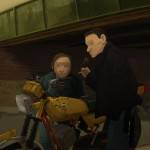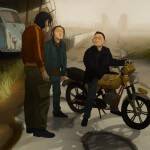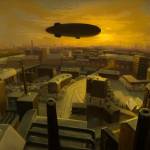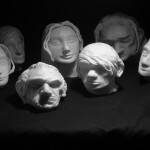Interview with Junkyard Director Hisko Hulsing
Junkyard tells the story of a “man who is robbed and stabbed on a metro train. As he lays dying, a friendship from his youth flashes before his eyes.”
The full length version of this stunning film has just been released online, which we recommend watching before reading our interview with director Hisko Hulsing.
How did you get started in animation and what do you love about the medium?
I studied painting at the art academy in Rotterdam and we had to choose a secondary course. My brother Milan Hulsing and I were both big comic lovers (especially the French ones, like Moebius, Tardi, Boucq and the Italians like Manara and Liberatore), so we thought that we might take the course and cooperate. Milan studied Illustration and became a great comic artis and illustrator, but I started the course and was hooked on animation pretty soon. Not only because I liked the limitless possibilities and the magic of creating life out of nothing, but also because it is so elaborate that there was hardly any time left for painting (apart from the backgrounds that I do with oil paint).
The thing I like most about animation is that I can combine my talents within one medium, I compose the music for my films, I write the stories, I draw and animate (with a small team up until now) and I paint the backgrounds. So it’s like creating a universe out of nothing.
Junkyard has an incredibly dark and strong story, how did the story development start?
Growing up in Amsterdam, I had some childhood friends that started their criminal careers at a very young age. I combined that with the darkness I went through when my overuse of Marihuna got me into a very erratic state at age 16. So I didn’t have to look far away, I could delve in my own past and construct a story out of that.
Did Junkyard go through many different changes in it’s long development?
Not so much. After writing 13 versions of the script I made a pretty detailed storyboard (which can be found on the DVD) and when we started production, I would change small things and board scenes again before we started to animate.
I did arrange a lot of feedback near the end, to make sure that the story was working.
You created Junkyard with a lot of different techniques, was this intentional from the start or did you develop the style as you progressed?
I developed it at an early stage, partly by accident. I made clayheads for reference but we ended up animating them in the computer before tracing parts of them. Same goes for the live action recordings. We planned to do them just for reference, but we ended up tracing parts of it and then exagerating where necessary. Painting the shadows digitally took a lot of time and some different approaches, but once the decision was made to do it this way, we couldn’t change it anymore. There are some parts that are animated 3D by Polder Animation, the ‘hardware’, trains, moped and cars. My paintings are projected on top of them.
But in general, once we started, within two months the complete style was established.
You’re heavily involved in your film-making process, what is your favourite part?
Painting, definitely. Painting comes pretty easy to me, and in the best cases it gets me in a strange and nice state. Almost a ‘high’.
Animating can be really really hard to do, and sometimes the repetitions are boring beyond comprehension. Composing music can be fun, but with a straight story like this, possibilities are limited. It’s not hard for me to come up with melodies and harmonies, but making sure that it supports the story is the main goal and that can be tough.
You also create the music for your films, do you think this gives you an advantage?
Yes, there are good film composers around, but the problem with a short film is that the chance is big that they will treat it as a little assignment in between other work. For me the stakes are very high. I know exactly what I want to achieve with the story, and music and visuals should be one. I happen to be musical and skilled enough to compose and arrange. My wife Carmen Eberz is a professional violinist, she corrects my scores and got an orchestra together. For Junkyard we had 18 musicians, all topskilled.
The film has a dark and mature setting why did you decide to use animation to produce this?
Animation is really the only kind of film-making that I master. I could have done this film with live-action, but there would be no way that it would get the same atmosphere and dreamlike quality.
I don’t think that animation should be used only for stories that can’t be told by live action. One of the most touching films I have ever seen is Grave of the Fireflies by Takahata. That film could easily have been done with live action. Maybe that film inspired me in that way. Could very well be.
Now that Junkyard is released online, do you have any details on you next project?
One project that I worked on intensely last year, is LAST HIJACK, directed by Femke Wolting and Tommy Pallotta (producer of WAKING LIFE and a SCANNER DARKLY). I made over 90 oilpaintings that are being projected on 3d animation. LAST HIJACK will premiere this Friday, 7th February at the Berlin Film Festival (view the trailer here).
There are several projects hanging in the air. Some of them might go through, but unfortunately I am not allowed to talk about any of them.
Many thanks to Hisko Hulsing, and you can buy the DVD (plus many additional extras) for €10,00 from here.







